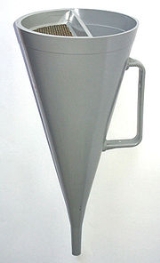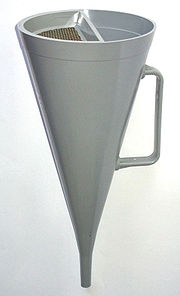
Marsh funnel
Encyclopedia
The Marsh funnel viscometer
is a simple device for measuring viscosity
from the time it takes a known volume of liquid to flow from the base of a cone through a short tube. It is particularly used by mud engineer
s to check the quality of drilling mud.

In use, it is held vertically and end of the tube closed with a finger. The liquid to be measured is poured through the mesh. (This removes any particles which might block the tube.) This ends when the mesh is reached, which gives a volume inside of about 1.5 litres. To take the measurement, the finger is released as a stopclock is started, and the liquid is allowed to run into a measuring container. The time in seconds is recorded as a measure of the viscosity.
In American practice (and most of the oil industry) the volume collected is a quart. If water is used, the time should be 26 +/- 0.5 seconds. If the time is less than this the tube is probably enlarged by erosion, if more it may be blocked or damaged, and the funnel should be replaced. In some companies, and Europe in particular, the volume collected is a litre, for which the water funnel time should be 28 seconds. Marsh himself collected 0.50 litre, for which the time was 18.5 seconds.
The Marsh funnel time is often referred to as the Marsh funnel viscosity, and represented by the abbreviation MF. The unit (seconds) is often omitted. Formally, the volume should also be stated.
The (quart) Marsh funnel time for typical drilling muds is 34 to 50 seconds, though mud mixtures to cope with some geological conditions may have a time of 100 or more seconds.
While the most common use is for drilling muds, which are non-Newtonian fluid
s, the Marsh funnel is not a rheometer
, because it only provides one measurement under one flow condition. However the effective viscosity can be determined from following simple formula.
μ = ρ (t - 25)
where μ = effective viscosity in centipoise
ρ = density in g/cm³
t = quart funnel time in seconds
For example, a mud of funnel time 40 seconds and density 1.1 g/cm³ has an effective viscosity of about 16.5 cP. For the range of times of typical muds above, the shear rate in the Marsh funnel is about 2000 -s.
industry, but also in the oil industry. Sometimes it means the Marsh funnel, sometimes a similar device with the same cone aspect ratio, but a different tube. European standard EN445 for measuring the flow properties of cement
grout
mixtures specifies a funnel similar to that described above but fitted with a tube of 10 mm internal diameter and of length 60 mm, which is often referred to as a Marsh cone. Some manufacturers supply devices which they call Marsh cones, with removable tubes with size ranges from 5 to 15 mm. These can be used for quality control by selecting a tube which gives a convenient time, say 30 to 60 seconds.
Other cones of different geometries and with different orifice arrangements are in use in specialist areas, but with the same general operating principle. They are generally called flow cones. Thus a Marsh cone is a flow cone with an aspect ratio
of 2:1 and a working volume of at least a litre. A Marsh funnel is a Marsh cone with a particular orifice and a working volume of 1.5 litres.
Viscometer
A viscometer is an instrument used to measure the viscosity of a fluid. For liquids with viscosities which vary with flow conditions, an instrument called a rheometer is used...
is a simple device for measuring viscosity
Viscosity
Viscosity is a measure of the resistance of a fluid which is being deformed by either shear or tensile stress. In everyday terms , viscosity is "thickness" or "internal friction". Thus, water is "thin", having a lower viscosity, while honey is "thick", having a higher viscosity...
from the time it takes a known volume of liquid to flow from the base of a cone through a short tube. It is particularly used by mud engineer
Mud engineer
A mud engineer works on an oil well or gas well drilling rig, and is responsible ensuring the properties of the drilling fluid, also known as drilling mud, are within designed specifications.-Use of mud:Mud is a vital part of drilling operations...
s to check the quality of drilling mud.

Description and Use
It consists of a cone 6 inches (152 mm) across and 12 inches in height (305 mm) to the apex of which is fixed a tube 2 inches (50.8 mm) long and 3/16 inch (4.76 mm) internal diameter. A mesh is fixed near the top across half the cone.In use, it is held vertically and end of the tube closed with a finger. The liquid to be measured is poured through the mesh. (This removes any particles which might block the tube.) This ends when the mesh is reached, which gives a volume inside of about 1.5 litres. To take the measurement, the finger is released as a stopclock is started, and the liquid is allowed to run into a measuring container. The time in seconds is recorded as a measure of the viscosity.
In American practice (and most of the oil industry) the volume collected is a quart. If water is used, the time should be 26 +/- 0.5 seconds. If the time is less than this the tube is probably enlarged by erosion, if more it may be blocked or damaged, and the funnel should be replaced. In some companies, and Europe in particular, the volume collected is a litre, for which the water funnel time should be 28 seconds. Marsh himself collected 0.50 litre, for which the time was 18.5 seconds.
The Marsh funnel time is often referred to as the Marsh funnel viscosity, and represented by the abbreviation MF. The unit (seconds) is often omitted. Formally, the volume should also be stated.
The (quart) Marsh funnel time for typical drilling muds is 34 to 50 seconds, though mud mixtures to cope with some geological conditions may have a time of 100 or more seconds.
While the most common use is for drilling muds, which are non-Newtonian fluid
Non-Newtonian fluid
A non-Newtonian fluid is a fluid whose flow properties differ in any way from those of Newtonian fluids. Most commonly the viscosity of non-Newtonian fluids is not independent of shear rate or shear rate history...
s, the Marsh funnel is not a rheometer
Rheometer
A rheometer is a laboratory device used to measure the way in which a liquid, suspension or slurry flows in response to applied forces. It is used for those fluids which cannot be defined by a single value of viscosity and therefore require more parameters to be set and measured than is the case...
, because it only provides one measurement under one flow condition. However the effective viscosity can be determined from following simple formula.
μ = ρ (t - 25)
where μ = effective viscosity in centipoise
ρ = density in g/cm³
t = quart funnel time in seconds
For example, a mud of funnel time 40 seconds and density 1.1 g/cm³ has an effective viscosity of about 16.5 cP. For the range of times of typical muds above, the shear rate in the Marsh funnel is about 2000 -s.
Marsh Cone
The term Marsh cone is sometimes used, particularly within the concreteConcrete
Concrete is a composite construction material, composed of cement and other cementitious materials such as fly ash and slag cement, aggregate , water and chemical admixtures.The word concrete comes from the Latin word...
industry, but also in the oil industry. Sometimes it means the Marsh funnel, sometimes a similar device with the same cone aspect ratio, but a different tube. European standard EN445 for measuring the flow properties of cement
Cement
In the most general sense of the word, a cement is a binder, a substance that sets and hardens independently, and can bind other materials together. The word "cement" traces to the Romans, who used the term opus caementicium to describe masonry resembling modern concrete that was made from crushed...
grout
Grout
Grout is a construction material used to embed rebars in masonry walls, connect sections of pre-cast concrete, fill voids, and seal joints . Grout is generally composed of a mixture of water, cement, sand, often color tint, and sometimes fine gravel...
mixtures specifies a funnel similar to that described above but fitted with a tube of 10 mm internal diameter and of length 60 mm, which is often referred to as a Marsh cone. Some manufacturers supply devices which they call Marsh cones, with removable tubes with size ranges from 5 to 15 mm. These can be used for quality control by selecting a tube which gives a convenient time, say 30 to 60 seconds.
Other cones of different geometries and with different orifice arrangements are in use in specialist areas, but with the same general operating principle. They are generally called flow cones. Thus a Marsh cone is a flow cone with an aspect ratio
Aspect ratio
The aspect ratio of a shape is the ratio of its longer dimension to its shorter dimension. It may be applied to two characteristic dimensions of a three-dimensional shape, such as the ratio of the longest and shortest axis, or for symmetrical objects that are described by just two measurements,...
of 2:1 and a working volume of at least a litre. A Marsh funnel is a Marsh cone with a particular orifice and a working volume of 1.5 litres.

